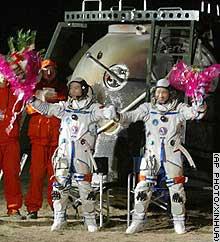Tuesday, October 18, 2005
China plans spacewalk, lunar exploration
 Following the successful completion of China’s second manned space flight, Chinese plans for space exploration appear to be running full speed ahead, with an ambitious agenda including spacewalks, lunar landers and orbiters, and a possible manned base on the moon, as reported by CNN:
Following the successful completion of China’s second manned space flight, Chinese plans for space exploration appear to be running full speed ahead, with an ambitious agenda including spacewalks, lunar landers and orbiters, and a possible manned base on the moon, as reported by CNN:BEIJING, China (AP) -- China hopes to conduct a spacewalk in 2007 and might recruit women into its next group of astronaut candidates, a senior space program official said Monday following the safe completion of the nation's second manned mission.
The Shenzhou 6 flight ended the first stage of China's plan, which focused on development of space vehicles, said Tang Xianming, director of the China Space Engineering Office.
The next stage focuses on developing ways for astronauts to walk in space and the ability to rendezvous and dock with other spacecraft, he said
.
"Our estimate is that around 2007 we will be able to achieve extravehicular activity by our astronauts and they will walk in space," he said at a news conference.
Those who dismiss the Chinese space program as simply doing what’s already been done, thirty years ago, by the Americans and Soviets, are missing the point. Japan and a European consortium have failed in efforts aimed at manned flight, largely abandoning those plans, although Japan still occasionally seems interested. Likewise, those who dismiss the Chinese efforts as little more than “buying” space travel vehicles and equipment from the Soviets are underestimating Chinese technology.
True, the Chinese are not doing anything that hasn’t been done before, but the fact is, no space mission, especially a manned mission, is a small accomplishment. And the Chinese program is obviously gaining confidence. This mission was far more complicated, and sophisticated, than the first Chinese manned flight in 2003.
Shenzhou 6 flew 2 million miles in 115 hours and 32 minutes in space, the official Xinhua News Agency said. The mission was far longer and more complex than the 2003 flight, when astronaut Yang Liwei orbited for 211/2 hours.
The Shenzhou 6 mission demonstrates that "China has grasped the core technology of manned space engineering and shows that China can independently solve high-technology problems and has earned a seat in the upper echelons of the world's science and technology fields," Tang said.
The Shenzhou 6 is a modified version of Russia's Soyuz capsule. China also bought Russian technology for spacesuits, life-support systems and other equipment. But space officials say all the items launched into orbit were Chinese-made.
The government already has announced plans to land an unmanned probe on the moon by 2010 and eventually send up an orbiting laboratory.
China said last year it would launch a moon-orbiting satellite in 2006. The 2-ton Chang'e satellite would orbit at least a year and record three-dimensional images of the lunar surface.
The lunar program -- named Chang'e after a legendary Chinese goddess who flew to the moon -- includes plans to land a vehicle by 2020 that would collect soil samples and conduct other tests, possibly in preparation for a manned moon base.
China clearly now has the ability, and apparently, the will, to become a third player in the outer space arena. To what end this ability may be directed is still anybody’s guess. But NASA and the US might want to consider this a wake-up call. Because of the pioneering efforts of the US and the Soviet Union, along with rapidly advancing technology, space, reachable only by science fiction writers fifty years ago, may get to be a pretty crowded place in the next fifty years.
(The photo reproduced above accompanied the CNN article linked in the post)
Subscribe to Comments [Atom]